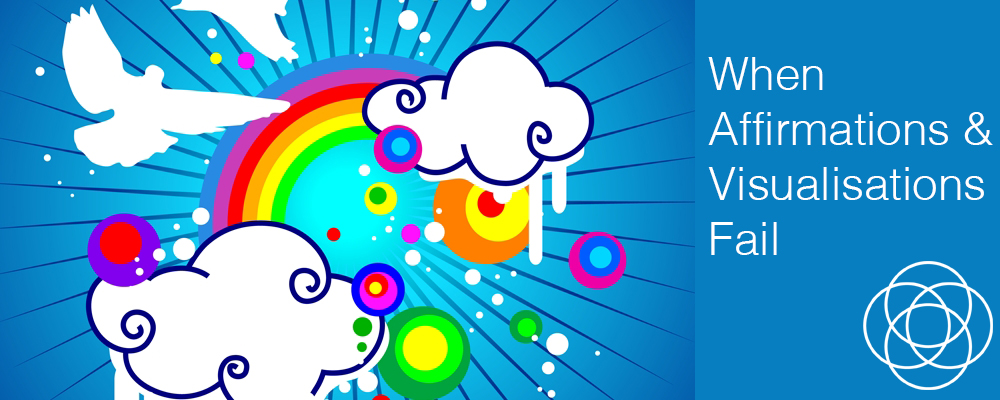How many times have you set an intention and created an affirmation or visualisation to guide its manifestation, only to fail or even magnify the problem?
Here’s a simple example.
You decide it’s time to get serious about losing some weight. You decide to do this by changing to a healthier diet. It’s all quite clear to you: you know what you want to achieve (lose some weight), and you know how to do it (you’ve done all your research and you have chosen a healthy diet you know you can follow).
You come up with something like:
Affirmation: “I am slim, confident, and attractive, and I enjoy eating healthy food.”
Or you might choose a visualisation in which you see yourself as slim, confident, and attractive, enjoying eating healthy food.
You may also have done some research into how to create a successful affirmation or visualisation:
You know that it must be positive (no negative words like “no more chocolate” or even “lose weight”).
You know it must be expressed or envisioned in the present tense, as something that is reality for you today (otherwise you’re affirming something that will always be in the future, always out of reach).
You know that you must include some positive emotions or feelings to engage your heart and give every uplifting reason to make it happen.
You also know that an affirmation or visualisation works best if you can engage all your senses, so you key in positive sights, sounds, tastes, smells, skin sensations (touch), and maybe even body movements that support your intention.
Sometimes these kinds of affirmations and visualisations work, but more often they fail. In this simple example, you may find that the more you do the affirmation the more you find yourself eating chocolate, or putting off the diet until tomorrow, or following the diet but staying the same weight or even gaining weight.
Every time you affirm a conscious intention, any unconscious beliefs or feelings that conflict with it will be called into battle.
One reason for these failures is that every time you affirm a conscious intention, any unconscious beliefs or feelings that conflict with it will be called into battle.
In our simple example, you may be affirming that you are slim, but if you have an unconscious belief that being slim will threaten your relationship with your partner, your affirmation will not only fail, it will massively fail. The affirmation calls up your unconscious belief and sends it into overdrive to do its job, which it sees as protecting your relationship from the repercussions of being slim. That’s when you find yourself automatically eating unhealthy food or engaging in other behaviours that not only sabotage your chances of becoming slim but possibly result in putting on more weight.
What makes doing an affirmation attractive in the first place?
Consider this too: what makes doing an affirmation attractive in the first place? If a new attitude or behaviour is easy to do, you just do it. It works. You don’t need an affirmation. When you can’t just do it, no matter how much you try, (when you unconsciously sabotage your good intention), you may decide to enlist the help of an affirmation. So the moment an affirmation seems like a good idea, it’s probably because you have unconscious beliefs to the contrary. And you now know where that’s going to get you!
Yes, I am coming to dreams – and to dream alchemy affirmations and visualisations and why they work.
Discovering the unconscious beliefs that sabotage you
One therapeutic approach (as described by Julia Cameron in her book The Artist’s Way), is to write down your affirmation and then listen to the negative voice at the back of your mind as it raises its objections. Some of those negative beliefs will be familiar to you, some may surprise you. If you do the work of tracing those negative beliefs back to their origins (when did you acquire them, from whom, what were the circumstances, how have they served you, what have they protected you from), you may then be able to do the healing work necessary to release or transform them. Once you have done that work and there’s no longer anything blocking your positive intention, your affirmation will succeed.
Here’s another approach that is more powerful, and much quicker.
Every night, your dreaming mind processes your conscious and unconscious experiences of the last one or two days. When you focus on repeating an affirmation or visualisation – and especially when that calls up powerful unconscious objections – your dreaming mind is going to process all of this. If you explore your dreams a day or two into your affirmations, you stand to gain deep insight into your unconscious beliefs and inner conflicts about your intention. But that’s not where I’m going today. Here’s where the magic begins.
Let’s look at a dream you might have while doing this affirmation
Imagine, still using our simple example, that you have spent a couple of days affirming, “I am slim, confident, and attractive, and I enjoy eating healthy food”. On the second night you dream of a tall, beautiful house built on thin wooden stilts. You see flames on one of the stilts, so you grab some water and put the flames out. But then you see more of the stilts catching fire, and you spend the whole dream putting out fires only to see more spontaneously combust. In the whole dream, you never get to spend any time in the upper storeys of the beautiful house. You spend all your time putting out fires and worrying about the stability of this house built on a foundation of thin, fiery stilts.
I made up the dream to illustrate the point. The dream features a beautiful house built on an unstable foundation of thin stilts that keep catching fire. The beautiful house is attractive (tick, you wanted to be attractive), but it is built on an unstable foundation (no tick for confidence, this whole structure could collapse), and its thin stilts keep catching fire (you’re angry – fiery – about what being thin/slim might lead to).
All the time you spend putting out fires in the dream reflects all the time you spend doing your affirmation, but the more you do this (the more you do the affirmation), the more your unconscious anger about being thin/slim sabotages what you’re trying to build.
If this was your dream – and not a simple example I made up – we would be able to identify the issue around being thin/slim that is still bringing up anger for you, stopping you from achieving your goal. But I promised you magic in the form of dream alchemy, and here it is:
Dream alchemy: talk to your unconscious mind in its own language
Your dream shows you the language your unconscious mind understands. It pictures your anger about being thin/slim as wooden stilts catching fire, and it pictures your lack of confidence as a lack of adequate support/foundation for the house.
In the language of the dream (which is also the language of your unconscious mind), if there were no fire (no anger), and if there were firmer support (perhaps the thin wooden stilts are replaced by slim, strong, marble columns), your beautiful house would stand tall and you’d be able to enjoy being in it.
In other words, if you had no anger about being thin, and if you allowed yourself more support for being slim, then you would enjoy being “slim, confident, and attractive” in perfect accord with your affirmation.
A dream alchemy affirmation is an affirmation where you talk to your unconscious mind in its own language to transform the belief that is sabotaging you into one that aligns with your conscious intention. It might look like this:
Affirmation: “I am standing in my tall, beautiful house, supported on solid, strong, slim, marble columns built on a cool marble foundation, and I’m feeling wonderfully confident and attractive.”
A dream alchemy visualisation is simply the visual version of the affirmation.
In each case, make sure they are in the present tense, and add the emotion you want to feel (confident). Make sure you feel that emotion when you speak your affirmation or do your visualisation. You can add in sensual references to engage the senses, but beware making it too complex. Speak plainly and clearly to your unconscious mind. Most importantly, transform the negatives without mentioning the negatives. Fiery wood becomes cool marble.
When you do your dream alchemy affirmations or visualisations (20-30 times a day for two weeks works well), you are communicating with your unconscious mind in its own language, gently transforming an unconscious belief by transforming the symbols that represent it. This is quite different from using a conventional affirmation (using the language of the conscious mind) that challenges the unconscious to rebel rather than coax it to change.
You’ll be surprised by how quickly dream alchemy affirmations and visualisations work. In the example, the ‘thin’ issue that was still causing you anger and sabotaging your good intent resolves, and you find yourself responding in the world in different ways, ways that bring your intention to fruition.
You might also enjoy


